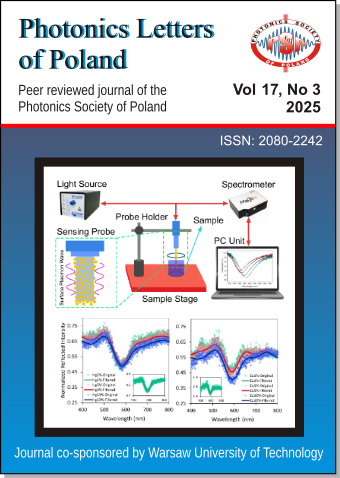Denoising the Reflection Spectrum of an LSPR-Based Optical Fiber Sensor Using Fast Fourier Transform in Python
DOI:
https://doi.org/10.4302/plp.v17i3.1297Abstract
This study explores the use of Fast Fourier Transform (FFT) for denoising signals from a Localized Surface Plasmon Resonance-based Optical Fiber (LSPR-OF) sensor. By applying FFT, high-frequency noise was effectively suppressed, enhancing measurement precision. An optimal cut-off frequency of 0.01 was identified for balancing noise reduction and signal preservation. Results demonstrated shifts in resonance wavelengths, with varying sensitivity across metals. The findings highlight the potential of FFT filtering to improve the clarity of LSPR spectrum.
Full Text: PDF
References
- K. Kant et al., ""Plasmonic nanoparticle sensors: current progress, challenges, and future prospects", Nanoscale Horizons 9, 2085 (2024). CrossRef
- Y. Hong, J. Ha, "Enhanced refractive index sensitivity of localized surface plasmon resonance inflection points in single hollow gold nanospheres with inner cavity", Scientific Reports 12, 1 (2022). CrossRef
- K.H. Chen, J. Hobley, Y.L. Foo, X. Su, "Wide-field single metal nanoparticlespectroscopy for high throughput localized surface plasmon resonance sensing", Lab on a Chip 11, 11 (2011). CrossRef
- S. Palani et al., "Multispectral Localized Surface Plasmon Resonance (msLSPR) Reveals and Overcomes Spectral and Sensing Heterogeneities of Single Gold Nanoparticles", ACS Nano 17, 3 (2023). CrossRef
- R. Aviles-Espinosa, H. Dor, E. Rendon-Morales, "An Experimental Method for Bio-Signal Denoising Using Unconventional Sensors", Sensors 23, 7 (2023). CrossRef
Downloads
Published
How to Cite
Issue
Section
License
Copyright (c) 2025 Wildan Panji Tresna, Lathifah Dika Mauludi, Ismudiati Puri Handayani, Dedi Riana, Ali Khumaeni

This work is licensed under a Creative Commons Attribution 4.0 International License.
Authors retain copyright and grant the journal right of first publication with the work simultaneously licensed under a Creative Commons Attribution License that allows others to share the work with an acknowledgement of the work's authorship and initial publication in this journal. Authors are able to enter into separate, additional contractual arrangements for the non-exclusive distribution of the journal's published version of the work (e.g., post it to an institutional repository or publish it in a book), with an acknowledgement of its initial publication in this journal. Authors are permitted and encouraged to post their work online (e.g., in institutional repositories or on their website) prior to and during the submission process, as it can lead to productive exchanges, as well as earlier and greater citation of published work (See The Effect of Open Access).




